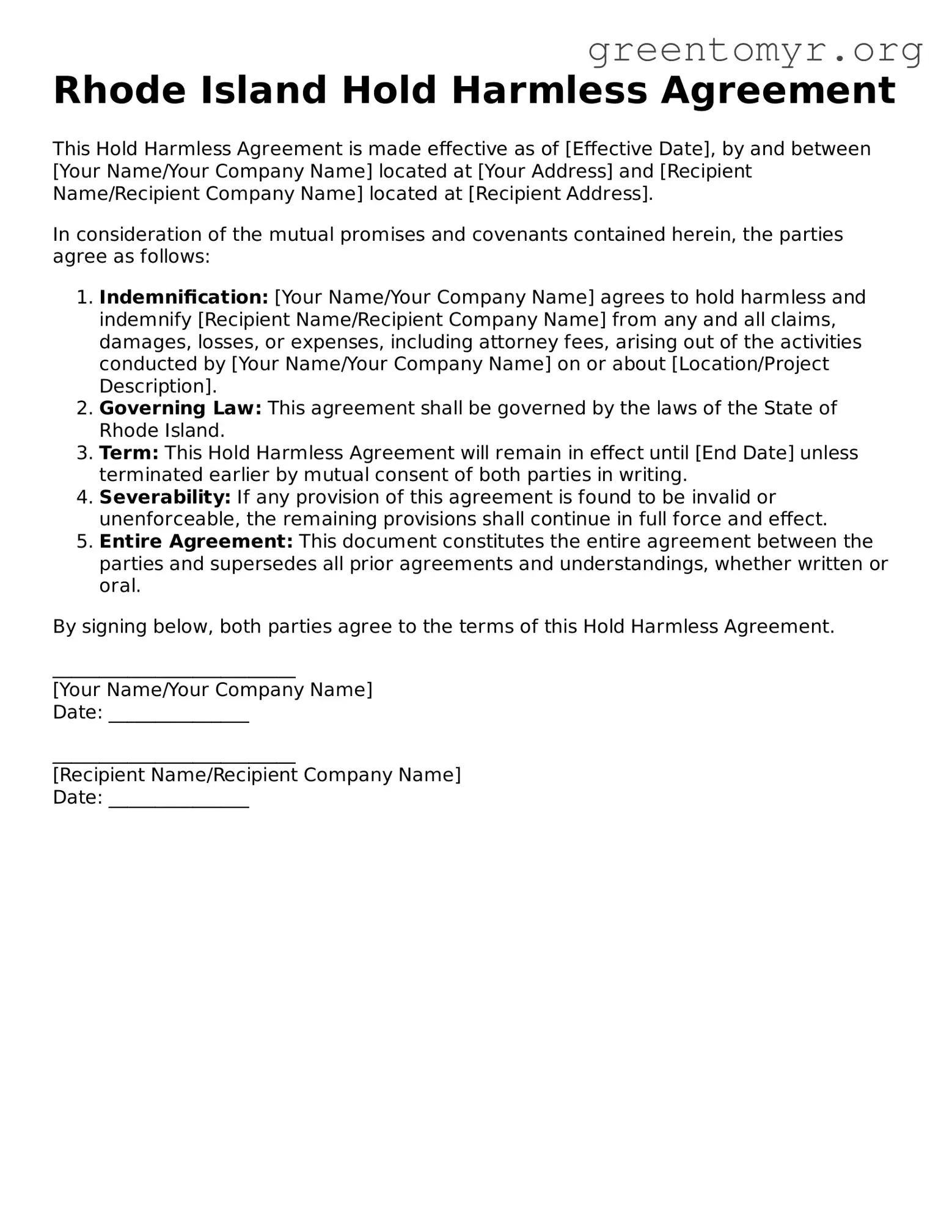What is a Hold Harmless Agreement in Rhode Island?
A Hold Harmless Agreement is a legal document that protects one party from liability for any damages, injuries, or losses that might occur during a specified activity or event. In Rhode Island, these agreements are often used in situations involving events, property rentals, and construction projects to ensure that one party agrees not to hold the other responsible under certain circumstances.
When should I use a Hold Harmless Agreement?
Such an agreement is typically utilized in various scenarios, including:
-
Rental agreements, where a landlord may want to protect themselves from tenant injuries.
-
Event planning, where organizers seek to protect against claims from attendees.
-
Construction contracts, to shield contractors from liability related to their work.
These agreements can provide peace of mind when engaging in activities that might pose risks to participants or properties.
Is a Hold Harmless Agreement legally binding in Rhode Island?
Yes, a properly drafted Hold Harmless Agreement is generally considered legally binding in Rhode Island, provided it adheres to state laws. To be enforceable, the agreement should be clear, specific, and voluntarily agreed upon by all parties involved. It is advisable to consult with a legal expert to ensure that the document meets all legal requirements.
Can a Hold Harmless Agreement protect against all liabilities?
No, while a Hold Harmless Agreement can provide significant protection, it does not shield a party from all forms of liability. Most agreements cannot protect against gross negligence or intentional misconduct. Courts may scrutinize the language and context of the agreement to determine its enforceability, particularly in cases involving severe negligence.
Do I need a lawyer to draft a Hold Harmless Agreement?
While it is possible to create a Hold Harmless Agreement without a lawyer, obtaining legal assistance is highly recommended. A legal expert can ensure the agreement is comprehensive and compliant with local laws, thereby providing stronger protection. Additionally, they can help tailor the agreement to the specific needs of your situation.
How do I enforce a Hold Harmless Agreement?
To enforce a Hold Harmless Agreement, you must demonstrate that all parties agreed to the terms voluntarily and that the document is clear in its language. If a dispute arises, the agreement should be presented as evidence in court. Legal representation may also be beneficial for navigating the enforcement process and addressing any complexities.
What should I consider before signing a Hold Harmless Agreement?
Before signing, consider the following factors:
-
Review all terms carefully to fully understand your responsibilities.
-
Assess any potential risks associated with the activity.
-
Consider consulting with a legal professional to clarify any uncertainties.
Taking these steps can help you make an informed decision that aligns with your best interests.
How long does a Hold Harmless Agreement remain valid?
The duration of a Hold Harmless Agreement can vary based on the terms outlined within the document. Some agreements may specify a particular time frame, while others remain in effect indefinitely, covering any incidents that may arise during the designated activity. Always ensure the terms regarding validity are clearly stated to avoid future confusion.
What if a Hold Harmless Agreement is found to be invalid?
If a court determines a Hold Harmless Agreement is invalid, the protections it offered may no longer apply. In such cases, liability could revert to the parties involved as dictated by prevailing laws. This outcome underscores the importance of drafting an agreement that is clear and legally sound. Consulting with a legal professional is crucial to minimizing risks.
